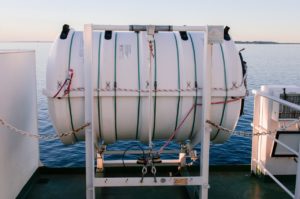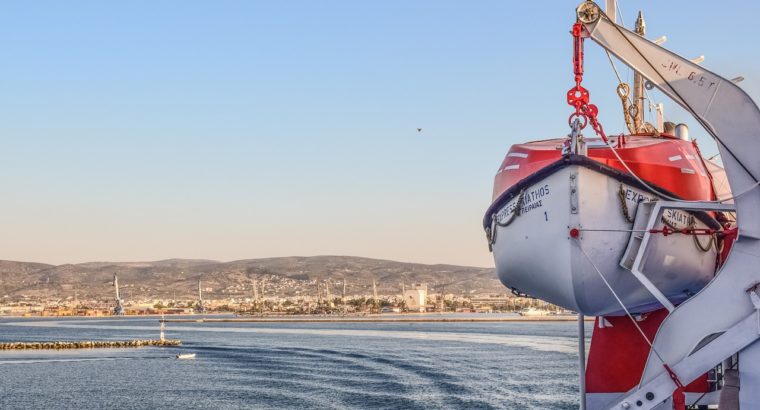Stay Safe on the Water with These Must-Have Boat Safety Gear
Boat safety gear is essential equipment that helps prevent accidents, injuries, and fatalities on waterways. This essay will cover the importance of boat safety gear, legal requirements for safety equipment, potential risks and hazards on waterways, and the different types of safety gear available. It will also discuss choosing, purchasing, maintaining, and storing safety equipment.
Importance of Boat Safety Gear
Boat safety gear plays a critical role in minimizing the risks associated with boating. Accidents can happen at any time, and the gear you have on board can make a significant difference in the outcome. Properly equipped boats are less likely to experience accidents, and in the event of an incident, the gear can help people stay afloat, signal for help, and even extinguish fires.
Legal Requirements for Safety Equipment
Boating regulations require that every vessel carries specified safety equipment. These requirements vary depending on the type of boat, the number of passengers on board, and the waters where you are boating. Failing to have the required gear on board could lead to fines, penalties, or legal action.
Potential Risks and Hazards on Waterways
Boating can be unpredictable, and water conditions can change rapidly. High winds, storms, and waves can be hazardous to boaters. Along with weather-related risks, there are also other hazards, such as collisions with other vessels, submerged objects, or running aground.
Personal Flotation Devices (PFDs)
PFDs are the most important safety gear. They come in various types and sizes and can make the difference between life and death. PFDs are designed to keep you afloat and usually made of buoyant materials.
Types of PFDs
There are five types of PFDs, each intended for different uses. Type I is suitable for offshore boating, and type V is ideal for specialized activities like kayaking or windsurfing. Types II, III, and IV can only be used in specific situations or as supplementary devices.
Proper Fit and Wear
Wearing a PFD is not just about having one on board; it’s also essential that you wear it correctly. Your PFD should fit snugly and comfortably and be adjusted correctly to secure it.
Maintenance and Inspection
All PFDs require maintenance to ensure they are safe to use. Regular inspection and maintenance can identify and fix issues like faulty straps or weak seams.
Visual Distress Signals (VDS)
VDSs are instrumental in alerting other boats and rescue crews of your position when you’re in an emergency. These distress signals come in different types and vary in their visibility and duration.
Types of VDS
Flares, smoke signals, and flags are common types of VDS used to get attention in distress situations.
When and Where to Use
While distress signals can be used in coastal waters, they are most effective in open waters and offshore areas.
Legal Requirements
Boats over 16ft in length require that they carry at least three signals flares for nighttime use or three combination day/night signals.
Sound-Producing Devices
Sound-producing devices like whistles, horns, bells, and sirens are critical in alerting other boaters of your position or danger.
Types of Sound-Producing Devices
Air horn, electric horn, and whistle are the most widely used sound-producing devices in boating gear.
When and Where to Use
Using sound signals can alert people to your presence, especially when visibility is limited. They are most effective in areas of heavy traffic.
Legal Requirements
A sound-producing device is required on all vessels and should be sounded when overtaking another vessel in a narrow channel.
Fire Extinguishers
Fire onboard a boat can spread quickly and become a life-threatening situation. Having a fire extinguisher on board can help control a fire before it becomes out of hand.
Types of Fire Extinguishers
Two commonly used fire extinguishers in boating are dry chemical and carbon dioxide. Both are effective in extinguishing fires caused by flammable liquids or electrical faults.
How to Operate
Before venturing out, ensure you know the location and how to operate your fire extinguisher.
Legal Requirements
Vessels over 26ft require the installation of a fire extinguisher. Smaller vessels have to carry at least one B-1 US Coast Guard-approved extinguisher.
Navigation and Communication Equipment
Navigation and communication devices are essential for boaters to navigate waterways and communicate with other vessels.
GPS and Chart Plotters
GPS and chart plotters are popular tools for navigation, and both make it easy for boaters to find locations, set waypoints, and chart routes on the water.
Radios and Emergency Beacons
Marine radios provide communication between boats and other services like the Coast Guard. Emergency beacons, like EPIRBs, are used to send a signal to rescue crews in the event of emergencies.
Legal Requirements
All boats larger than 26ft require a VHF radio, and most vessels are required to carry an emergency beacon.
First Aid Kits
Accidents can happen, and being prepared for them is important. A well-stocked first aid kit on board can help treat minor injuries and provide some temporary relief in emergencies.
Essential Items for a Boat First Aid Kit
A boat first aid kit should ideally contain a range of supplies like bandages, gauze, antiseptics, and pain relief medication.
Best Practices for First Aid Procedures
It is essential to have basic knowledge of first aid procedures. Boaters should have training in first aid and take a course to learn about emergency procedures.

Legal Requirements
Boats operating in federal waters are required to carry first aid equipment.
Anchoring and Docking Equipment
Mooring and docking safely is crucial when boating. Having the appropriate anchoring and docking equipment can make the process safe and easy.
Anchors and Lines
Anchors and lines are necessary for the mooring of vessels. Every vessel should carry a suitable anchor and a length of anchor rope.
Fenders and Bumpers
Fenders and bumpers protect a boat’s hull from docking and mooring damage.
Legal Requirements
“Navigational lights and anchoring lights” are required under vessel safety laws.
Bilge Pumps and Float Switches
A bilge pump removes water from the bilge of a boat. These pumps can keep up with minor water leaks or completely empty the bilge in an emergency.
Types of Bilge Pumps and Float Switches
Different types of bilge pumps and float switches are available that operate automatically or manually.
Maintenance and Inspection
Regular inspection and maintenance are necessary to ensure that the water removal system works in critical situations.
Legal Requirements
All vessels should have an adequate bilge pump onboard.
Lighting and Electrical Systems
Boats require navigation lights for safe boating during nighttime and low visibility conditions.
Types of Boat Lights
Navigation lights, deck lights, anchor lights, and searchlights are essential lighting systems in boats.
Battery Maintenance and Inspection
Batteries are essential to power electronic systems on a boat, and they should be adequately maintained and inspected at regular intervals.
Legal Requirements
All boats must carry proper navigation lighting systems that are visible from 2 miles away.
Weather Forecasting and Monitoring
Boaters should stay informed about weather changes and forecasts during their trip on the water.
Importance of Monitoring Weather Conditions
Weather forecasts can protect boaters from harsh weather like storms and heavy rains.
Types of Weather Forecasting Tools
GPS and weather radio forecasts can help boaters make informed decisions.
Legal Requirements
Weather forecasting tools are not mandatory; however, it’s strongly recommended to carry them on board.
Personal Safety Equipment
Wearing protective gear while boating is essential, and it can protect you from extreme weather, ultraviolet light exposure, or other risks like slipping or falling.
Protective Gear for Boating Activities
Sunglasses, sunscreen, shoes, and life jackets are essential safety equipment for boating activities.
Best Practices for Safety
It’s important to follow best practices like keeping an eye on the weather, wearing appropriate clothing, and not consuming alcohol while boating.
Legal Requirements
There are no legal requirements for protective gear. However, it is recommended to wear life jackets.
Emergency Procedures
Boaters should always be prepared to handle emergencies effectively.
Preparation and Communication During an Emergency
Make sure that everyone on board is aware of the location of safety equipment and how to use it. Communication devices should be tested before the trip.
Basic Emergency Procedures
Being prepared for emergencies with first aid, swimming skills, and the ability to radio for help should be included while planning for a safe boating trip.
Legal Requirements
Boaters are not legally required to have any special training for emergencies.
Miscellaneous Safety Equipment
Boaters should carry additional safety equipment that could come in handy in unexpected emergencies.
Water-Resistant Bags and Containers
Water-resistant bags and containers can keep important documents and electronics dry.
Emergency Rations and Water Supplies
It’s also important to carry a supply of food and water on board, especially during long trips or when emergency situations arise.
Legal Requirements
While it’s not mandatory to keep miscellaneous safety equipment, it’s prudent to be prepared in case of an emergency.
Safety Training and Education
Boaters should undergo basic safety training and education for safe boating on the water.
Importance of Safety Training and Education
Safety training and education courses equip boaters with knowledge of essential safety equipment, boating rules and regulations, and emergency procedures.
Types of Training Courses and Programs
There are courses like the Safe Boating Certificate Program or boating safety courses offered by different organizations like the US Coast Guard, American Red Cross, or the National Association of Boating Law Administrators.
Legal Requirements
Most states have mandatory boating safety education or certification programs.
Choosing the Right Gear
Several factors need to be considered while choosing safety gear.
Factors to Consider When Choosing Safety Gear
Size of the boat, type of activity, and number of passengers are all factors that determine the gear that should be carried on board.
Recommendations and Reviews for Safety Gear
Boaters should research different safety gear and read reviews to determine the best options for their specific needs.
Legal Requirements
Boaters are required to carry designated safety equipment based on the vessel’s length and other factors mentioned before.
Purchasing Safety Equipment
Boaters should purchase safety equipment from reputable sources.
Where to Buy Safety Equipment
Safety equipment can be purchased at boating accessory stores, online stores, and through manufacturers.
Tips for Buying Safety Equipment
Boaters should ensure that the equipment they buy meets the legal requirements and has good reviews and ratings.
Maintaining and Storing Safety Equipment
Proper maintenance and storage of safety equipment can extend its life and effectiveness.
Proper Maintenance and Storage Techniques
All equipment should be cleaned, checked regularly, and stored in a dry place.
Inspection and Replacement Guidelines
Inspecting and replacing old or ineffective safety equipment is essential for continued safety on board.
The safety of everyone on board should be the top priority for boaters. Ensuring that boats are equipped with a complete set of safety gear that meets legal requirements and that equipment is well maintained and stored is critical. Be diligent and prepared to mitigate risks and enjoy safe boating.
